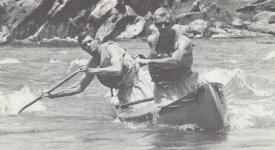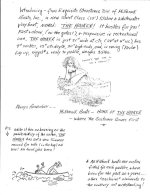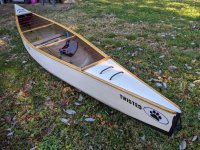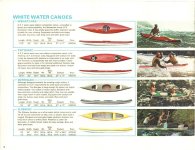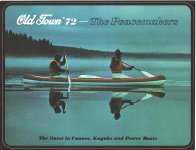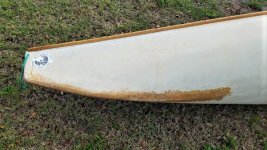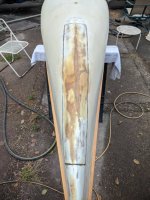John Berry was a whitewater mentor, letter correspondent and friend of mine in the 1980's. I recently rediscovered some letters from him from that era, and thought I would share a biographical tribute to him, his canoes, and his risqué humor in three posts. First, some straight biography:
Millbrook Boats, currently owned by John Kazimierczyk, was started in 1959 by one of the true pioneers of whitewater racing, open and closed canoe design, and multiple whitewater river first descents—John Berry (1924-2011). Millbrook is the whitewater open canoe line that has won more slalom races than any other since 1959. Millbrook boats have also always been used by discerning recreational whitewater canoeists who value composite light weight, speed, acceleration, and whiplash turns.
A World War II veteran and Wharton graduate, John Berry paddled with the Washington D.C. Canoe Cruisers club and lived in Bethesda, Maryland, in the 1950’s, working as a sales executive and stock broker. Sometime in the 1960's, he dropped out of the financial world, put his Wharton degree over his toilet, and began making boats and running a ski lodge in Waitsfield, Vermont. He first called the company Mad River Canoes and Kayaks in 1965.
Jim Henry later started a company in Waitsfield that he called Mad River Canoe. John and Jim decided that only one of them should be able to call their fledgling enterprises by the name Mad River. So, instead of going to court, they went to the local bar.
John first proposed that they settle the name dispute by an axe throwing contest, as he was a champion axe thrower. Jim didn't fall for this ploy. So they flipped a coin for it, and Jim Henry won. John Berry changed the name of his company to Millbrook Boats in 1971, named after a tributary of the Mad River that flowed by his ski lodge.
In 1975, John Berry moved Millbrook Boats to Riparius, NY, in the Adirondacks, where he personally trained and sold boats to legions of disciples (including yours truly, to whom he personally told this history), who went on to spread the gospel of light weight composite canoes and modern whitewater slalom technique.
Having "imported" one of the first Hahn closed boats into the U.S. when he was the national C-1 champion, John Berry used the Hahn hull (as John Sweet also did) to be the basis of the best known Millbrook boats of the 70's and 80's: the Flasher, the Flashback, the AC/DC, the MJM, the Fog, and the legendary ME. Jim Henry's Mad River Canoe also was licensed to make the Flashback and ME.
John Berry's most talented paddling apostle was John Kazimierczyk, who bought Millbrook from Berry in 1988.
Millbrook Boats, currently owned by John Kazimierczyk, was started in 1959 by one of the true pioneers of whitewater racing, open and closed canoe design, and multiple whitewater river first descents—John Berry (1924-2011). Millbrook is the whitewater open canoe line that has won more slalom races than any other since 1959. Millbrook boats have also always been used by discerning recreational whitewater canoeists who value composite light weight, speed, acceleration, and whiplash turns.
A World War II veteran and Wharton graduate, John Berry paddled with the Washington D.C. Canoe Cruisers club and lived in Bethesda, Maryland, in the 1950’s, working as a sales executive and stock broker. Sometime in the 1960's, he dropped out of the financial world, put his Wharton degree over his toilet, and began making boats and running a ski lodge in Waitsfield, Vermont. He first called the company Mad River Canoes and Kayaks in 1965.
Jim Henry later started a company in Waitsfield that he called Mad River Canoe. John and Jim decided that only one of them should be able to call their fledgling enterprises by the name Mad River. So, instead of going to court, they went to the local bar.
John first proposed that they settle the name dispute by an axe throwing contest, as he was a champion axe thrower. Jim didn't fall for this ploy. So they flipped a coin for it, and Jim Henry won. John Berry changed the name of his company to Millbrook Boats in 1971, named after a tributary of the Mad River that flowed by his ski lodge.
In 1975, John Berry moved Millbrook Boats to Riparius, NY, in the Adirondacks, where he personally trained and sold boats to legions of disciples (including yours truly, to whom he personally told this history), who went on to spread the gospel of light weight composite canoes and modern whitewater slalom technique.
Having "imported" one of the first Hahn closed boats into the U.S. when he was the national C-1 champion, John Berry used the Hahn hull (as John Sweet also did) to be the basis of the best known Millbrook boats of the 70's and 80's: the Flasher, the Flashback, the AC/DC, the MJM, the Fog, and the legendary ME. Jim Henry's Mad River Canoe also was licensed to make the Flashback and ME.
John Berry's most talented paddling apostle was John Kazimierczyk, who bought Millbrook from Berry in 1988.

